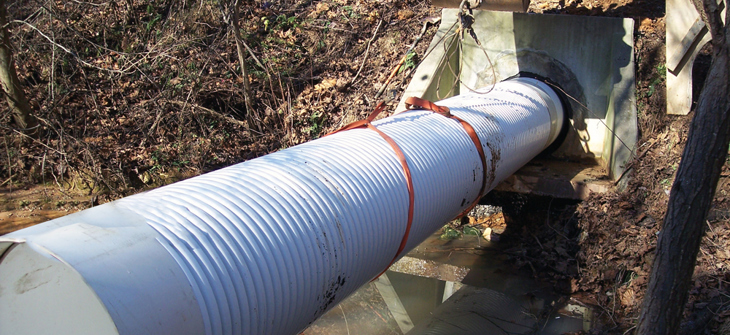
How Can Relining with PVC Improve Hydraulics?
Addressing the Deterioration of Sanitary & Storm Sewer Infrastructure
SewerU.S. sewer infrastructure continues to see increasing rates of sanitary and storm sewer deterioration and a need for cost-effective rehabilitation solutions. Contech has such a solution, with A2™ Liner PVC pipe. A2 Liner pipe is an augmentation of Contech’s A-2000™ PVC pipe, meeting the requirements of ASTM F949 & D3212. A2 Liner, with its reconfigured homogeneous bell and spigot was developed for the rehabilitation / slip lining of sewers and culverts. This proven product and application has been utilized across the US when dig and replace wasn’t a desirable alternative. Using slip lining helps avoid intrusive and disruptive construction associated with open trenching — while increasing productivity and lowering costs.
More importantly, A2 Liner pipe can in many instances increase hydraulic capacity. When reinforced concrete pipe has offset joints, cracks, spalling or protrusions, there is greater resistance to flow, reducing hydraulic capacity. Significant hydraulic improvements are achieved when these deteriorated pipes are sliplined with A2 Liner. Its glossy smooth interior creates a Manning’s “n” value of 0.009, resulting in potential increased flow capacity.
When slipling with A2 Liner, here are some considerations:
- Inspect and clean the existing pipeline and verify the liner clearance prior to sliplining.
- Remove any obstructions, protrusions, debris, or other irregularities that could damage or prohibit passage of the liner pipe.
- Install the liner pipe by either pushing or pulling it through the existing pipe. The leading pipe spigot end is usually fitted with a nose cone to help the liner pipe ride over small joint misalignments and other small obstructions or inconsistencies in the existing host pipe.
- The pipe jacking/pushing loads should be monitored. Excessive force could telescope pipe joints or damage the liner pipe. The safe compressive/jacking loads for A2 Liner Pipe are listed in Contech’s Installation Guide.
- When required, service reconnections can be accomplished by small point repairs using PVC tapping saddles or INSERTA TEE® fittings.
- The annular space between the liner pipe and the host pipe is usually filled with cement or cellular grout, depending on site conditions. Low-strength grouts (150-1,000 psi compressive strength) are typically used.
Please consider this “no dig” alternative when you have an existing sewer or culvert in need of rehabilitation.
